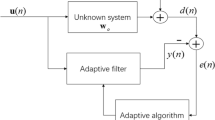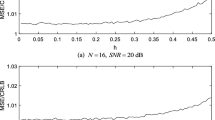Abstract
Spread-spectrum communication systems are now commonly used in the field of cellular telephone positioning. However, wireless positioning systems by low-power spread-spectrum communication are extremely vulnerable to high-power interference, which limits achievable measurement precision. In this paper, a bandwidth variable wavelet notch filter design method is proposed to suppress a large number of jammers in multiple locations with noise interfering with spread-spectrum systems. The filter uses combinations of Gaussian wavelets with optimal time-frequency localization and computational efficiency for real-time operation of denoising. The performance of the adaptive filter has been evaluated by experiments associated with a spread-spectrum communication system model employing a reliable noise detector to locate the filter notch. Experimental results demonstrate that the proposed wavelet notch filter removes the narrow-band interference in accordance with the corrupted frequency contents while minimizing signal distortion and information loss, which leads to high-precision wireless positioning.
Similar content being viewed by others
References
A. Aldroubi, M. Unser, Wavelets in Medicine and Biology (CRC Press, Florida, 1996)
M.G. Amin, Interference mitigation in spread spectrum communication systems using time-frequency distributions. IEEE Trans. Signal Process. 45(1), 90–101 (1997)
J. Bas, A. Perez, M.A. Lagunas, Differential fuzzy filtering for adaptive line enhancement in spread spectrum communications. Signal Process. 86(5), 984–1009 (2006)
L.F. Chaparro, R. Suleesathira, Non-stationary jammer excision in spread spectrum communications via discrete evolutionary and Hough transforms. Signal Process. 83(5), 1117–1133 (2003)
J.W. Choi, N.I. Cho, Suppression of narrow-band interference in DS-spread spectrum systems using adaptive IIR notch filter. Signal Process. 82(12), 2003–2013 (2002)
C.K. Chui, An Introduction to Wavelets (Academic Press, Boston, 1992)
C.K. Chui, Wavelets: A Tutorial in Theory and Applications (Academic Press, New York, 1992)
I. Daubechies, Ten Lectures on Wavelet (SIAM, Philadelphia, 1992)
J.F. Doherty, Linearly constrained direct-sequence spread-spectrum interference rejection. IEEE Trans. Commun. 42(234), 865–872 (1994)
G.B. Folland, A. Sitaram, The uncertainty principle: a mathematical survey. J. Fourier Anal. Appl. 3(3), 207–233 (1997)
R.A. Iltis, L.B. Milstein, Performance analysis of narrow-band interference rejection techniques in DS spread-spectrum systems. IEEE Trans. Commun. 32(11), 1169–1177 (1984)
E.D. Kaplan, Understand GPS: Principles and Applications, 2nd edn. (Artech House Publisher, Berlin, 2006)
R. Klukas, G. Lachapelle, M. Fattouche, Cellular telephone positioning using GPS time synchronization. GPS World 9(4), 49–54 (1998)
R.J. Landry, P. Mouyon, D. Lekaim, Interference mitigation in spread spectrum systems by wavelet coefficients thresholding. Eur. Trans. Telecommun. 9(2), 191–202 (1998)
G.Y. Luo, D. Osypiw, M. Irle, Real-time condition monitoring by significant and natural frequencies analysis of vibration signal with wavelet filter and autocorrelation enhancement. J. Sound Vib. 236(3), 413–430 (2000)
M.J. Medley, G.J. Saulnier, P.K. Das, Narrow-band interference excision in spread spectrum systems using lapped transforms. IEEE Trans. Commun. 45(11), 1444–1455 (1997)
L.B. Milstein, Interference rejection techniques in spread spectrum communications. Proc. IEEE 76(6), 657–671 (1988)
J.G. Proakis, Digital Communications. Electrical Engineering Series, 4th edn. (McGraw-Hill, New York, 2001)
K.D. Rao, M.N.S. Swamy, E.I. Plotkin, A nonlinear adaptive filter for narrowband interference mitigation in spread spectrum systems. Signal Process. 85(3), 625–635 (2005)
L.A. Rusch, H.V. Poor, Multiuser detection techniques for narrowband interference suppression in spread spectrum communications. IEEE Trans. Commun. 43(3), 1725–1737 (1995)
T.H. Stitz, M. Renfors, Filter-Bank-Based narrowband interference detection and suppression in spread spectrum systems. EURASIP J. Appl. Signal Process. 2004(8), 1163–1176 (2004)
G. Strang, T. Nguyen, Wavelet and Filter Banks (Wellesley-Cambridge Press, Wellesley, 1996)
W. Sweldens, The lifting scheme: a construction of second generation wavelets. SIAM J. Math. Anal. 29(2), 511–546 (1998)
M. Tazebay, A. Akansu, Adaptive subband transforms in time-frequency excisers for DSSS communication systems. IEEE Trans. Signal Process. 43(11), 2776–2782 (1995)
J. Wang, E. Geraniotis, Narrow-band interference suppression in spread spectrum communication with iterative decoding, in Proceedings of IEEE Sixth International Symposium on Spread Spectrum Techniques and Applications, vol. 1, pp. 98–101 (2000)
M.I. Youssef, A.E. Emam, M. Abd Elghany, Direct sequence spread spectrum technique with residue number system. Int. J. Electr. Comput Syst. Eng. 3(4), 223–230 (2009)
Author information
Authors and Affiliations
Corresponding author
Rights and permissions
About this article
Cite this article
Luo, G. Wavelet Notch Filter Design of Spread-Spectrum Communication Systems for High-Precision Wireless Positioning. Circuits Syst Signal Process 31, 651–668 (2012). https://doi.org/10.1007/s00034-011-9335-4
Received:
Revised:
Published:
Issue Date:
DOI: https://doi.org/10.1007/s00034-011-9335-4




